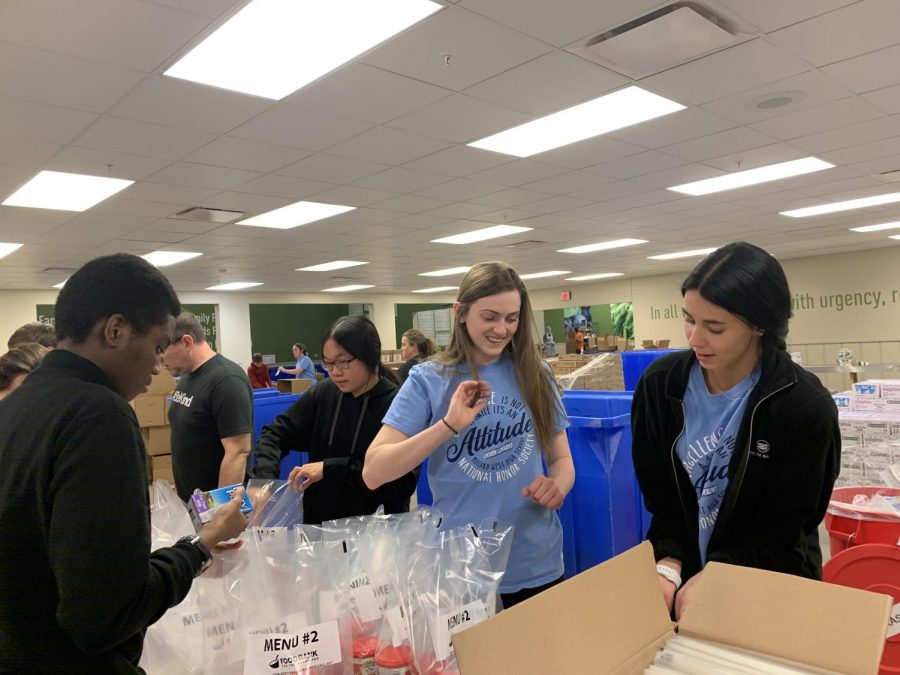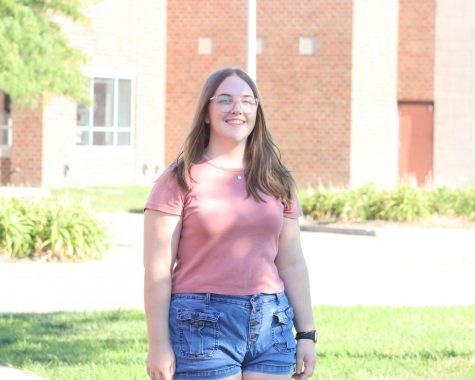Feeding the community
Students volunteer at Food Bank for the Heartland
photo courtesy of Stacey Kozisek
Members of National Honors Society pack bags with fruit and juice at Food Bank for the Heartland to be donated to families. “Whenever I have time I always try to do things like this because I really enjoy helping people,” junior Jordan Bakar said. “It was fun engaging with people and working with others to help out the community.”
December 13, 2019
As people gear up for the holiday season, many are finding ways to give back to the community. Food banks have long been the first choice for those looking to serve and for good reason.
A report by the Food Research and Action Center in 2018 found that one in eight Nebraskans struggle to afford food for themselves and their families and 16% of Nebraska families deal with food insecurity.
The Food Bank for the Heartland is often the go-to spot for Millard West groups looking to volunteer. Headquartered in Omaha, the food bank serves 93 counties in Nebraska and Western Iowa. It is the largest food bank in the region and offers the opportunity for students to serve people within their own community. Heartland subcontracts to more than 600 different food pantries, shelters and schools in the area who serve the food to people in need.
During the two hour sessions at Heartland, volunteers do anything from sorting food that’s been donated to making sure produce hasn’t gone bad. The food is donated from community members, businesses, grocery stores and organizations like Feeding America. Last year, they helped provide 22 million meals.
“It’s a very humbling experience because we take food for granted everyday, so going to the Food Bank for the Heartland, you just see how important it is,” junior Emma Baker said. “They told us it’s going out to families before Friday so it’s cool that we’ll be waking up with that feeling of having made a difference on Saturday morning.”
Bryant Bull, a Human Diversity and AP US history teacher, has been recruiting students and teachers to volunteer at the Food Bank for the Heartland for around six years. He enlists members of his Justice and Diversity League along with students from his classes every month. Recently, they have also joined up with Key Club and National Honors Society for some productive volunteering sessions.
“The last time we went, we made around 33 bags per person per hour which is above their 30 per person per hour goal,” Bull said. “I always go in with a goal of helping everybody out enough to get to 30 bags per person per hour.”
Recently, volunteers have been helping out with the Backpack Program. Since 2006, the Backpack Program has been serving elementary students who struggle with food insecurity. Volunteers sort, package and seal bags that include entrees, cereal, milk, juice and fruit. These bags are distributed every Friday to local schools where they are given to kids in need to take home for the weekend. Each week, Food Bank for the Heartland provides 8,040 of these bags to children. During their volunteering session in October, members of Justice and Diversity and Key Club helped put together 976 bags. Some of these bags will be going to children here in Douglas County, where the child food insecurity rate is 18%.
“Someone you know may be silently struggling with food insecurity – a neighbor, a classmate, an employee at a store or restaurant you frequent,” Food Bank for the Heartland communications manager Angie Grote said. “Food banks and their networks of pantry partners provide a critical resource for individuals and families who frequently have to choose between paying for medical expenses, utilities, car repairs or other things and buying food.”
Beyond providing meals, food banks offer student groups the chance to bond and feel like they’re part of their community. It’s more than a way to rack up mandatory service hours; volunteering reminds teens that children and peers within their own area face hunger and poverty. It also reminds them that they can do something about it.
“The food bank has given me perspective on how much people are struggling in our own community,” senior Olivia Oeth said. “A lot of people are struggling from lack of nutrition and they don’t have the money to get the food they need. Volunteering has shown me just how much donating and giving your time can do.”
The holiday season means families who are financially struggling are further strained. As some worry about getting all of their presents bought on time and booking flights to see family, others are worrying about where their next meal will come from. The holiday season also means more people are taking the time to volunteer and think about how they can give back to their community.







